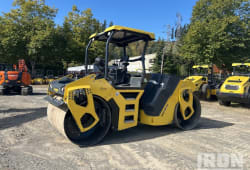Navigating Heavy Equipment Safety Checklist in Mining, Construction & Oil & Gas Industry
8 Lectura mínima
)
enero 6, 2024
Ensuring heavy equipment safety is an overarching priority within the Mining, Construction, and Oil and gas industries. Seasoned operators, despite their experience, conscientiously undertake a thorough walk-around inspection of their machinery before embarking on daily operations.
This innovative feature addresses the challenges of time constraints and potential oversight that operators might encounter during a manual inspection. By condensing the process into a five-minute routine, it not only enhances operational efficiency but also encourages consistent adherence to safety protocols. This reduction in inspection time is not just a convenience; it's a strategic investment in risk mitigation and workplace safety.
Operators who neglect or hastily perform this essential step expose themselves and their colleagues to increased risks. Beyond the immediate concerns of potential equipment malfunction, the compromised safety standards might have ripple effects, affecting overall operational efficiency and potentially leading to accidents or extended equipment downtime. Emphasizing the significance of this streamlined daily inspection is not just about time saved but underscores a commitment to the well-being of the operators and the broader workplace safety culture.
Daily Operator Checklist
In safety-critical sectors like mining, construction, and oil & gas, the daily inspection of heavy equipment is not just a routine; it's a safety imperative. Operators, whether seasoned or new, adhere to a mental checklist before starting their daily tasks.
This meticulous routine covers crucial components, from tire conditions to fluid levels, ensuring optimal machinery performance and upholding rigorous safety standards.
In the subsequent sections, we explore the specific checkpoints operators diligently cover in their daily ritual, emphasizing the vital role this process plays in averting potential issues and fostering a safety-centric culture within these dynamic industries.
Tires
Inspecting tires is a fundamental aspect of the daily operator checklist. This involves a detailed examination for signs of wear, checking for cracks, ensuring correct inflation levels, and scrutinizing tracks for any damage or debris accumulation. Tires, being a primary point of contact with the ground, demand meticulous attention to maintain optimal traction, stability, and overall equipment performance. This thorough examination ensures a proactive approach to safety, identifying potential issues before they escalate.
Fluid Levels
Monitoring fluid levels is a critical facet of the daily operator checklist. This involves a comprehensive check of various fluids essential for the equipment's proper functioning. Operators meticulously inspect water, ensuring an adequate supply for cooling systems. Additionally, they assess fuel levels, crucial for sustained operation. Examination of engine oil, hydraulic oil, and transmission oil ensures optimal lubrication, preventing potential issues. This diligent scrutiny of fluid levels safeguards against unexpected breakdowns, contributing to the overall safety and efficiency of the heavy equipment.
Windows
Examining windows for cracks and ensuring cleanliness is a pivotal aspect of the daily operator checklist. Operators meticulously assess the integrity of the windows, searching for any signs of cracks or damage that could compromise visibility or safety. Simultaneously, maintaining cleanliness is emphasized to guarantee unobstructed views during operation. This routine check on the windows ensures a clear line of sight for operators, promoting a safer working environment and preventing potential hazards associated with impaired visibility.
Blades
Operators systematically inspect blades, buckets, or scoops as part of their daily checklist, scrutinizing each component for signs of wear and potential issues. The focus is on identifying cracks, assessing the condition of teeth for breakage, and ensuring proper linkages. This thorough examination aims to detect any structural weaknesses that could compromise the equipment's functionality or safety during operation. By addressing concerns related to cracks, broken teeth, and linkages, operators contribute to maintaining the optimal performance and longevity of heavy equipment in mining, construction, or oil and gas industries.
Inside Cab Damage
When conducting the daily operator checklist, a crucial aspect involves inspecting the interior of the cab. Operators meticulously examine the cab for any damage, ensuring that the structural integrity is maintained. They also pay attention to cleanliness, promoting a safe and comfortable working environment. Additionally, operators verify the presence and accessibility of a fire extinguisher, enhancing preparedness for emergency situations. This comprehensive examination of the cab interior aligns with heavy equipment safety protocols, emphasizing the importance of a well-maintained and equipped workspace for operators in the mining, construction, or oil and gas sectors.
Walk-around inspection
Commencing with the walk-around inspection, the operator proceeds to start the engine; however, heavy equipment safety protocols extend beyond this point. Even as the machine warms up, the operator engages in another walk-around, utilizing both visual and auditory senses. This additional inspection involves checking for potential issues such as air leaks in the system, oil or water leaks, and exhaust problems. Within the cab, the operator monitors gauges for correct pressures, ensuring optimal functioning. This meticulous post-start inspection serves as a final layer of assurance, contributing to the overall heavy equipment safety and maintenance strategy in the dynamic environments of mining, construction, and the oil and gas industry.
Follow Up
Subsequent to the warm-up period, a thorough and comprehensive secondary walk-around is systematically executed, harnessing the synergy of both visual acuity and auditory perception, thereby elevating the standards of heavy equipment safety to new heights. This meticulous inspection unfolds as a multifaceted process, addressing crucial facets that are instrumental in ensuring operational integrity and minimizing potential risks in sectors such as mining, construction, and the oil and gas industry.
During this detailed scrutiny, the following aspects are subjected to a stringent evaluation:
Detection of Air Leaks:
A meticulous search for any signs of air leaks within the intricate system of the heavy equipment, ensuring airtight efficiency in operational components.
Detection of Air Leaks: Conduct a meticulous examination to identify any potential air leaks within the complex system of the heavy equipment.
Airtight Efficiency: Ensure airtight integrity in various operational components to maintain high levels of operational efficiency.
Preventing Hazards: Addressing air leaks promptly is crucial to prevent safety hazards and maintain the overall safety of heavy equipment.
Indicators: Look for subtle signs such as hissing sounds or fluctuations in system pressure as indicators of possible air leaks.
Operational Reliability: Promptly addressing air leaks contributes to the operational reliability and longevity of heavy equipment.
Industry Relevance: This rigorous focus on airtight efficiency is particularly relevant in industries like mining, construction, and oil and gas where heavy equipment plays a pivotal role.
Optimal Performance: Commitment to stringent maintenance practices ensures heavy equipment operates at optimal capacity, minimizing the risk of unexpected malfunctions.
Identification of Oil or Water Leaks
Scrutiny extends to identifying any potential leaks in the critical fluids, namely oil and water, preventing any compromise in the equipment's performance.
Identification of Oil or Water Leaks: Conduct a thorough examination to identify potential leaks in critical fluids, specifically oil and water, to prevent any compromise in the equipment's performance.
Preserving Fluid Levels: Ensuring the integrity of fluid systems is crucial to preserving optimal fluid levels, contributing to the efficient functioning of heavy equipment.
Preventive Measures: Addressing oil or water leaks promptly is a preventive measure to avoid potential damage to the equipment and maintain reliable performance.
Environmental Impact: Preventing leaks is not only essential for equipment functionality but also minimizes the environmental impact of fluid spillage.
Sustainable Operations: A commitment to identifying and rectifying leaks aligns with sustainable practices, promoting responsible and environmentally conscious heavy equipment operations.
Enhanced Longevity: Proactive measures to prevent leaks contribute to the enhanced longevity of heavy equipment, reducing the frequency of maintenance and associated downtime.
Operational Safety: Ensuring the absence of oil or water leaks is integral to maintaining operational safety standards in industries where heavy equipment is employed.
Exhaust-Related Issues
A comprehensive assessment of the exhaust system is conducted, ensuring optimal functionality and compliance with safety standards.
Gauge Monitoring Inside the Cab
Within the confines of the operator's cab, a vigilant eye is cast over gauges, ensuring they reflect accurate and optimal pressure levels, a pivotal factor in sustaining seamless heavy equipment operations.
This holistic approach to inspection solidifies the heavy equipment safety framework, assuring operational reliability and fostering a secure working environment in high-stakes industries.
This dual-sensory approach fortifies the heavy equipment safety protocol, minimizing the risk of operational discrepancies in mining, construction, and the oil and gas industry.
Despite sounding time-consuming, experienced operators complete this comprehensive inspection within five minutes using our Operator Daily Inspection process. Neglecting this step can lead to longer equipment downtime, making that five minutes a worthwhile investment in heavy equipment safety and maintenance.
Conclusion
In conclusion, heavy equipment safety is paramount in the mining, construction, and oil & gas industries. Our innovative solution streamlines the daily operator inspection to just five minutes, efficiently addressing time constraints and potential oversights. This reduction is not just convenient; it's an investment in risk mitigation and workplace safety.
The meticulous checklist covers tires, fluid levels, windows, blades, and the cab, ensuring proactive risk management. Following the walk-around inspection, a second examination, using both visual and auditory senses, enhances operational integrity by addressing air leaks, oil or water leaks, exhaust problems, and gauges inside the cab.
Despite initial appearances, experienced operators efficiently complete this comprehensive inspection within five minutes using our Operator Daily Inspection process. Neglecting this step risks prolonged equipment downtime, emphasizing the crucial investment in heavy equipment safety and maintenance.

Caleb Woods is an experienced content specialist and an editor at Boom & Bucket, blending his journalism background with expertise in the heavy equipment industry. He delivers engaging, informative content to help professionals stay informed and make smarter decisions in the machinery market.














